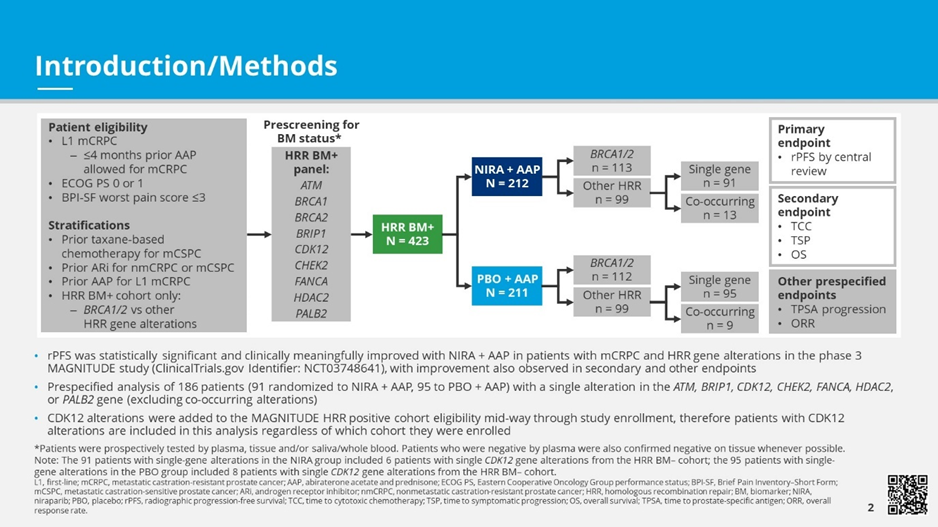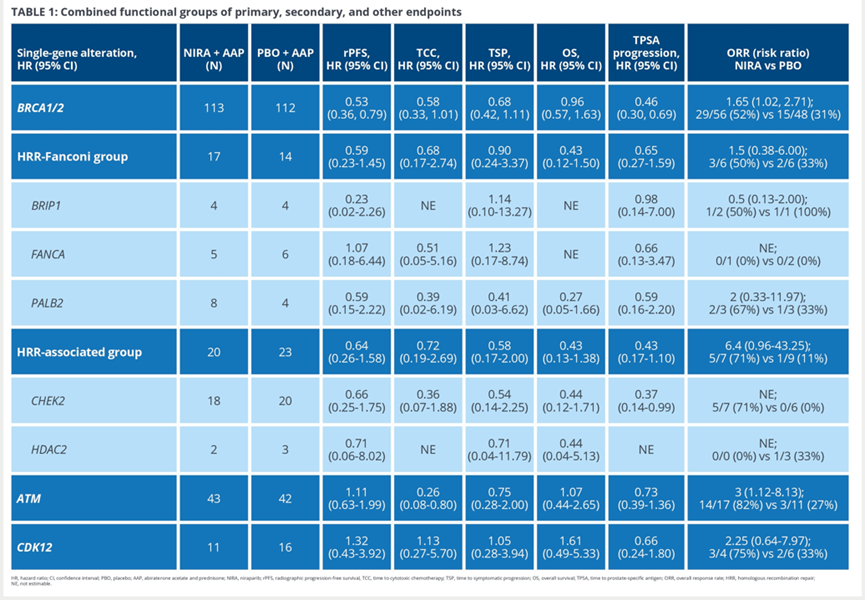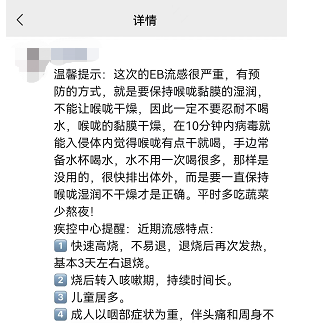[2022 ASCO] Thick accumulation │HRR mutation MCRPC treatment research progress progress is based on analysis
Author:Cancer Channel of the Medical Time:2022.06.16
*For medical professionals for reading reference


The 2022 ASCO Annual Conference was held in the form of online and offline conferences from June 3-7. During the meeting, a number of genetic mutations and metastasis resistance of prostate cancer (MCRPC) were released during the meeting. This article mainly shared three studies, which are the efficacy of patients with the cornerstone scheme in the Magnitude Studies to treat the HRR gene mutation patients, and The patient's health -related quality of life and the analysis of HRR gene mutations in prostate cancer patients in China. Professor Li Lei, Department of Urology, the First Affiliated Hospital of Xi'an Jiaotong University was invited to conduct in -depth interpretations for everyone.
Magnitude Study: Nira Pali (Nira) and acetic acid niram and AAP combined with the treatment of migraine degradation of homologous reorganization (HRR) gene mutations (HRR) genetic discharge resistance resistance prostate cancer (MCRPC) patients one by one. Analysis [1] (poser BD#204)
Magnitude studies have confirmed that Nira+AAP can significantly improve the prognosis of BRCA1/2+sub -groups and all HRR BM+patients, but currently lacks data that supports PARPI for the treatment of patients with HRR gene mutations in BRCA1/2+. This study evaluated the curative effect of Nira+AAP with a single HRR gene mutation (other than BRCA1/2). A total of 186 patients carrying ATM, BRIP1, CDK12, Chek2, FANCA, HDAC2 or PALB2 single -gene mutations were randomly distributed to the Nira + AAP group (n = 91) or PBO + AAP (n = 95). The main ending is the imaging of the Blind Independence Center Examination Committee (BICR). The secondary end point is the time to the cytotoxic chemotherapy time (TCC), the symptom progress time (TSP), and the total survival period (OS). Other endpoints include PSA progress (TPSA) and objective relief rate (ORR) (Figure 1).

Figure 1 Study design
The results showed that among patients with mutations in PALB2 or CHEK2, HDAC2 gene mutations, Nira+AAP therapy benefits at all research end points. After receiving Nira+AAP treatment, patients with ATM mutations have observed benefits in TCC, TSP, TPSA, and ORR. The only patients with CDK12 mutations benefit only TPSA and ORR. BRIP1 mutant patients seem to only benefit RPFS. After the genetic function group, patients with HRR-Fanconi pathway (BRIP1, FANCA, PALB2) and HRR-related variations (Chek2, HDAC2) were treated with Nira combined with Abbit dragon and Pennisone. Essence (See Table 1).
Table 1 The Gene-Efficacy Analysis of Magnitude Study

The above data supports the conclusion of the preliminary analysis of Magnitude research. In patients with mutations in HRR gene mutations other than BRCA1/2, the survival improvement of Nira+AAP therapy was observed. Nira United AAP was among patients with mutations in all HRR gene mutations including BRCA1/2 mutations including BRCA1/2 mutations. Benefit.
Magnitude Research: Nira Pali (Nira) and acetic acid niram and AAP combined therapy to carry homologous reorganization repair (HRR) gene mutations (HRR) genetic mutation resistance resistance to patients with prostate cancer (MCRPC) patients (MCRPC) Life quality (HRQOL) and Pain Analysis [2] (Poser BD#243)
The results of Magnitude's previous research confirmed that Nira + AAP can improve the survival benefits of HRR mutations MCRPC patients, and adverse reactions are controllable. The ASCO conference made relevant reports on the health -related quality of life (HRQOL) and pain in Magnitude Studies.
Patients of patients with physical energy status (ECOG) ≤1, concise pain meter score (BPI-SF) ≤3. HRQOL assessment includes overall quality of life (Fact-P) and BPI-SF. The analysis compares the changes in the baseline of each treatment group, and the time between the two groups to the intensity of pain intensity (TTD). The proportion of patients with internal organs, bone metastasis, and EGOG PS patients with 1 point are higher than the PBO+AAP group.
The results show that Nira + AAP can maintain a healthy related quality of life. FACT-P total scores, physical health scores, with changes in time, or there are no significant differences between group comparison (Figure 2). Compared with the PBO + AAP group, the pain intensity of the Nira + AAP group has a extension trend (11.1 months vs 10.1 months, HR = 0.87) (Figure 3).

Figure 2 FACT-P Total Rating is based on the changes in the baseline (left) and FACT-P body health based on the baseline changes (right) with the baseline (right)

Figure 3 BPI-SF Pain intensity changes (left) and the time of pain intensity worsening (right) over time (left)
In summary, most patients can maintain a lower pain level and good HRQOL in the treatment of NIRA combined with AAP treatment. Although patients who receive Nira +AAP treatment have reported the aggravation of adverse reactions in the early FACT-P evaluation, symptoms usually usually It's slight. The result also further supports the use of Nira + AAP treatment in patients with HRR mutations. Genetic diagram and homologous restructuring (HRR) gene mutation analysis [3] (ABSTRACT E17020) in China's prostate cancer patients with prostate cancer [3] (ABSTRACT E17020)
HRR gene mutations have proven to be effective biomarkers for PARP inhibitors (PARPI) to treat MCRPC. However, the genetic data of prostate cancer patients with prostate cancer patients and the characteristics of HRR gene mutation characteristics are insufficient. This domestic research uses 733pane to perform NGS tests on tissue and blood samples of patients with 250 prostate cancer. The system or embryo of the HRR pathway gene, including reduced copy number, CNV deficiency (Copy Number Variation (copy number mutation) is defined as HRR mutation positive.
The results of the study show that the mutation gene of the high -frequency system in China's prostate cancer includes FOXA1 (24.9%), TP53 (15.2%), and MYC (13.6%), while high -frequency embryo mutation gene includes DPYD (17.1%), UGT1A1 (13.2%) (13.2%) ) And SLX4 (4.3%). In the HRR pathway gene, 25.6%of patients carry HRR gene mutations. The system gene with the highest mutation frequency is CDK12 (9.7%), ATM (4.7%), and BRCA2 (3.9%). 3.1%), PALB2 (1.9%) and BRCA1 (1.6%). Of the 45 HRR mutations positive cases with homologous restructuring (HRD) scores, most of them carry single HRR gene mutations (CDK12 is 40.0%, ATM or BRCA2 is 17.8%, BRCA1 is 11.1%, PALB2 or FANCA is 2.2%) Only 8.9%of patients carry more than one HRR gene mutation. Among the 45 patients, 61 HRR gene mutations were detected. Single base replacement was the most common HRR gene mutation type (47.5%), while CNV lack (14.8%) was detected in samples of body cells. The HRD score of the HRR mutation group is significantly higher than the wild group (HRD score median, mutant VS wild type = 23.5 vs 19.0, P = 0.0097), and CNV deficiency is not statistically significant from other mutant HRD scores. The tumor mutation load (TMB) of the HRR mutation group has a trend higher than the wild group (TMB median, mutant VS wild type = 4.5 vs 2.8muts/mb, P = 0.5).
The study showed the characteristics of HRR gene mutations in prostate cancer patients in China and showed that HRR gene mutations were related to higher HRD scores. These data provide further evidence for the clinical management of PARPI personalized therapy.
Expert Reviews
MCRPC is the end of prostate cancer. The choice of front -line treatment schemes will directly affect the survival benefits of patients. Although the introduction of chemotherapy drugs and new endocrine drugs has greatly reshaped the treatment of prostate cancer to a large extent, the overall benefits are still very limited. With the development of medical technology and in -depth exploration of molecular biology, accurate, accurate, and Individualized diagnosis and treatment are expected to bring new breakthroughs.
A variety of DNA injury detection, identification and repair systems with complete function in the cells. DNA repair is an important link for the body to maintain DNA structure integrity and stability to ensure the continuation of life and the stability of species. MCRPC has high heterogeneity. About 1/4 patients have DNA damage repair related gene mutations. Under normal circumstances, tumor cells depend on DNA single -chain repair (including PARP) and DNA dual chain repair (including homologous restructuring) and other channels. To ensure the stability of its cell genome. If the homologous reorganization repair function defect (HRD), on this basis, the PARP inhibitors inhibit the PARP function, which can cause the apoptosis of tumor cells through the "synthetic death" effect [4]. The HRR gene is a set of genes that play an important role in the upstream and downstream of the same source restructuring and the DNA dual chain break repair. The HRR -related genes have mutated or other changes, which will cause HRD. The reorganization repair path also includes many other genes of upstream and downstream regulation. They also play an important role in the repair of DNA dual chain breaks. The currently recognized HRR -related genes include ATM, Bard1, BRIP1, CDK12, Chek1/2, FANCL, etc. [5].
The results of Magnitude's preliminary study [6] have confirmed that among the MCRPC patients with mutations in BRCA1/2, the Nichapari +Abbit Dragon scheme can significantly extend the patient's RPFS. Except for BRCA1/2, can patients with mutation of other HRR genes benefit from the PARP inhibitors with Abbit Dragon treatment? The ASCO meeting reported on the Magnitude Studies other than BRCA1/2 genes other than the BRCA1/2 genes. Or patients with HRR gene mutations such as PALB2 have observed the survival improvement of Nira +AAP therapy. In addition to extending survival, it is also important to improve the quality of life of patients with MCRPC. This conference also reported HRQOL data in Magnitude Studies. The results show that patients can maintain good quality of life after Nira +AAP treatment. The results of this research on the characteristics of HRR gene mutations in Chinese prostate cancer patients published in the conference will help guide the clinical reasonable selection of PARP inhibitors, improve the treatment ending of patients with prostate cancer Chance. Throughout the treatment of MCRPC, the inhibition of the androgen pathway is still the cornerstone. Profound [7] studies the prelude to the precise treatment of prostate cancer, and Magnitude Study and Propel [8] research Yi provides new ideas for precision treatment of prostate cancer. In fact, the DNA injury repair pathway and the AR channels can affect each other. Pre-clinical studies suggest that Parpi and Abbit Dragon have a synergistic anti-tumor effect. On the one hand, PARP suppression can help Abbit Dragon block the AR channel [9-100 ]; On the other hand, the transcription of the DNA damage repair pathway (DDR) gene (DDR) gene (DDR) gene transcription of AR pathway inhibitors [10-11], combined treatment can enhance the "synthetic death" effect. In addition to PARP inhibitors, SBRT combined with Abbit Dragon, Paborzab, and the clinical study of MCRPC such as the treatment of MCRPC in combination with Abitlon, Capivasertib combined with Abbita, hopes Joint treatment can better solve the treatment of patients with advanced prostate cancer.
Expert Introduction
Professor Li Lei
Professor, chief physician, researcher, doctoral supervisor;

Director of the Department of Urology at the First Affiliated Hospital of Xi'an Jiaotong University, subject leader;
Deputy Chairman of the Shaanxi Medical Association;
Leadership of the Youth Committee of the Chinese Medical Association to transform the medical science group;
The Deputy Chairman of the Youth Committee of the Urology Branch of the Chinese Research Hospital;
Mainly engaged in the foundation and clinical work of urinary tumors such as prostate cancer, bladder cancer, and kidney cancer. It is the leader of sub -prostate cancer sub -prostate cancer in Xi'an Jiaotong University. treat;
Obtain one project of the Ministry of Science and Technology's "973" and "863" project, 1 key research and development plan sub -project of the Ministry of Science and Technology, and independently host 4 youths and projects on the National Natural Science Foundation of China. In the previous project, there were 62 SCI containers.
references:
[1] 2022 Asco Poster BD#204.
[2] 2022 Asco Poster BD#243.
[3] j clin oncol 40, 2022 (substr E17020).
[4] TeysSonneau d, et al. PRostate Cancer and Parp Inhibitors: Progress and Challenges.j hematol oncol. 2021.
[5] Abida W, Et Al. Provective Genomomic Profling of Prostate Cancer Across Disease States Reveals Germline and Somatic AFECT Clinical Decision. Jco Precis.
[6] j clin oncol 40, 2022 (substr 12).
[7] Maha Hussain, et al. N English J Med. 2020 DEC 10; 383 (24): 2345-2357.
[8] j clin oncol 40, 2022 (substr 11).
[9] PolkingHorn Wr et al. Cancer Discov, 2013; 3 (11); 1245–53. [10] Schiewer MJ et al. Cancer discov 2012; 2: 1134–49.
[11] ASIM M et al. Nat Commun 2017; 8: 374.
*This article is only used to provide scientific information to medical people, and does not represent the viewpoint of this platform


- END -
Can "ammonia" really save the joints, or "IQ tax"?The pharmacist tells you the truth

A friend told Huazi that her mother was so painful that she had a good knee after ...
Fuzhou friends circle madly: EB flu is serious?The truth is here

In the past few days, everyone's circle of friends and various WeChat groups have ...